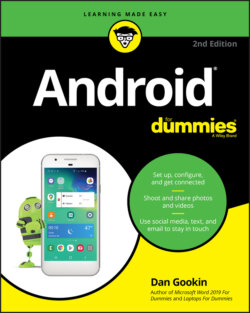Читать книгу Android For Dummies - Dan Gookin - Страница 20
Discovering what’s what and where
ОглавлениеTake a gander at Figure 1-1, which illustrates common items found on the front and back of a typical Android phone. Android tablets are similar, though larger.
Not every item shown in the figures may be in the exact same spot on your device. For example, the Power/Lock key might be found on the top edge, not on the side.
The terms used in Figure 1-1 are used throughout this book and found in whatever scant Android documentation exists. Here are the highlights:
Power/Lock key: This button, or key, turns the device on or off as well as locks or unlocks the device. Directions for performing these activities are found in Chapter 2.
Volume key: The volume control is two-buttons-in-one. Press one side of the key to set the volume higher, or the other side to set the volume lower.
Touchscreen: The biggest part of an Android gizmo is its touchscreen display, which occupies almost all the territory on the front of the device. The touchscreen is a look-touch gizmo: You look at it but also touch it with your fingers to control the Android.
Front camera: The front-facing camera, found above the touchscreen, is used for taking self-portraits as well as for video chat.
FIGURE 1-1: Your phone’s face and rump
Rear camera: The rear camera is found on the back (duh). Some devices feature multiple lenses for different focal lengths or special effects. The camera may be accompanied by one or more LED flash gizmos.
Speaker(s): The primary phone speaker is located top-center, above the touchscreen. One or more additional speakers might also be found on the phone’s bottom edge or backside. Tablets feature stereo speakers on either side of the device, though some smaller tablets may have their speakers on the back.
Microphone: Somewhere below the touchscreen, you’ll find the phone’s microphone. It’s tiny, about the diameter of a pin. Don’t stick anything into the hole! A second, noise canceling microphone might also be found on the back of the phone. Android tablets put the microphone along the edge, typically on the bottom.
Headphone jack: Somewhere on the device’s edge is the hole where you can connect standard headphones. If the headphone jack is missing, you must use wireless headphones; see Chapter 18 for details on Bluetooth.
Removable storage slot: Into this slot you insert a microSD card, which expands the device’s storage. Not every Android features this expansion option. See Chapter 19 for more details.
SIM card cover: This spot is where you access a cellular device’s SIM card, as covered earlier in this chapter.
USB/Power connector: This slot is where you connect the USB cable, which is used both to charge the battery and to connect your Android to a computer.
Take a moment to locate all items mentioned in this section, as well as shown in Figure 1-1. It’s important that you know where these items are on your device.
As you might expect, some devices feature extra doodads, beyond the basics here. For example, you may find a row of navigation icons along the bottom of the touchscreen. Older Samsung devices feature a physical Home button. Newer Samsung devices have a Bixby button, used to summon Samsung’s eager digital assistant.
The back of the phone may feature a fingerprint scanner, which is used to unlock the device. Refer to Chapter 22.
The Galaxy Note line of Androids features a digital stylus pointing device called an S Pen. It slides into the device’s bottom edge.
It’s common for some phones to feature controls on the back. You may find the power button (near the top-center on the back of the phone), a volume key, or a fingerprint scanner.
